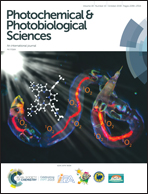Dynamics and efficiency of photoswitching in biliverdin-binding phytochromes†
Abstract
The light-driven conversions between the dark-adapted and the photoproduct state were recorded for bacteriophytochromes (BphP) carrying biliverdin IXα (BV) as chromophore by time-resolved absorption spectroscopy. BphPs can be photoswitched between a red absorbing (Pr, maximum at ca. 700 nm) and a far-red/near-infrared (Pfr, maximum at ca. 750 nm) absorbing state, thereby showing a considerable red-shift with respect to plant phytochromes. Representatives for BphPs studied here are: PstBphP1 from Pseudomonas syringae pv. tomato, for which Pfr is the photoproduct; the bathy-phytochrome PaBphP from Pseudomonas aeruginosa for which instead Pfr is the thermally stable parental state. The third BphP-like protein was FphA from the fungus Aspergillus nidulans, a eukaryotic protein also carrying BV as a chromophore, for which Pr is considered to be the dark-adapted state. All three BphPs show a canonical modular arrangement with a three-domain photosensory module (PAS-GAF-PHY) and a histidine-kinase (HK) signalling domain. The quantum yields for Pr-to-Pfr photoconversion are in the range 0.02–0.12, and 0.04–0.08 for the Pfr-to-Pr route. Photoproducts of both bacterial phytochromes thermally recovered in the dark, whereas for the fungal protein (FphA) both Pr and Pfr forms are thermally stable for days and could be interconverted only by selective irradiation. The photoinduced reactions of all three BV-phytochromes are in general kinetically less complex than those of plant phytochromes, with the notable exception of the Pr-to-Pfr route for PstBphP1. By contrast in the Pfr-to-Pr conversion of FphAN753 the final product is already formed during the very early steps of the process, without formation of any further intermediates: to our knowledge it is the first phytochrome showing this behavior. All three proteins investigated are weakly fluorescent in the Pr form, with a maximum fluorescence quantum yield of 0.02 (PaBphP), and have undetectable fluorescence in the Pfr state.



 Please wait while we load your content...
Please wait while we load your content...